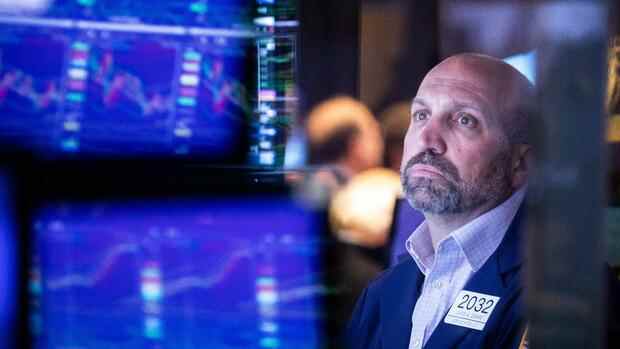Frankfort, New York Fear of a recession as a result of the Ukraine war and rapidly rising interest rates continue to plague investors on Wall Street. The US indices were undecided on the day at the end of the week. Shortly before the close of trading, they were able to make up some of the losses. The leading index Dow Jones closed 0.4 percent down at 32,901 points, the broader S&P 500 lost 0.52 percent and closed at 4126 points. The Nasdaq was again the biggest loser, down 1.35 percent and down 12,152 points. The Nasdaq even lost 2.7 percent for a short time. The balance sheet on the stock markets is bleak. It is the fifth consecutive week of losses for the S&P 500 and the Nasdaq. That was last a good ten years ago, when the markets were struggling with the euro crisis and the aftermath of the financial crisis. The Nasdaq is now 25 percent below its all-time high from November.
“Investors cannot buy equities with confidence because there is too much uncertainty about global growth and how the US Federal Reserve plans to proceed with interest rate policy in the fall,” said Ed Moya of analyst firm Oanda. The only bright spot was in the energy sector, with the S&P Energy sector up almost 3% and up 10% since the start of the week. The oil company Chevron gained 2.7 percent, Exxon was a good 1.5 percent.
According to experts, robust signals from the labor market provided no reason to question the US Federal Reserve’s monetary tightening course – on the contrary. Last month, 428,000 new jobs were created, while economists polled by Reuters had only expected 391,000. “On the one hand, investors want to see a strong job market that prevents the economy from falling into recession,” said Konstantin Oldenburger, market analyst at CMC Markets. “On the other hand, this must not become too strong so that they can believe the words of Fed Chair Jerome Powell that there will be no rate hikes above 50 basis points.”
Powell initially ruled out further hikes on a larger scale of 75 basis points after the 50 basis point interest rate hike on Wednesday. But many doubted that a tightening of the Fed’s pace would be off the table in the coming weeks. On the futures markets, investors currently see a 75 percent chance that interest rates will rise by 75 basis points in the June meeting. Powell continued to receive criticism for his course on Friday. “You can’t step in front of the cameras and talk about the many uncertainties we are currently dealing with and at the same time rule out a dedicated option,” complained economist Mohamed El-Erian, who advises Allianz, among other things, to the financial services provider Bloomberg .
Top jobs of the day
Find the best jobs now and
be notified by email.
Investors speculate on rising interest rates in the euro area
In addition to the US Federal Reserve, the actions of the European Central Bank (ECB) with regard to the interest rate turnaround have not let investors go. Speculations of an imminent interest rate hike in the euro area increased after French ECB council member Francois Villeroy de Galhau called for an end to bond purchases in the second half of the year – which is considered a prerequisite for an interest rate hike. The euro followed the ebb and flow of equity markets in the $1.05 to $1.06 range. Most recently, the price settled at $1.0548 in the mid-day range. The European Central Bank (ECB) set the reference rate at 1.0570 (Thursday: 1.0568) dollars. The dollar thus cost 0.9461 euros.
US Treasuries were slightly lighter on Friday. The 10-year bond futures contract fell 0.29 percent to 117.72 points. The opposite return rose to 3.13 percent during this term. It was thus at the level of the end of 2018.
The fear of supply bottlenecks due to the EU Commission’s impending oil embargo against Russia drove up the oil price on the commodity markets. Brent rose 1.9 percent to $113.06 a barrel. WTI traded a good two percent higher at $110.52 a barrel. On Wednesday, the Commission decided on a sixth package of sanctions, including an oil embargo.
Wall Street expert Koch: “The real wave of capital outflows is still to come”
Individual values in focus
Under Armour: Under Armor shares plummeted 27.2 percent to a 20-month low of $10.40. The US sporting goods manufacturer expects a full-year profit below expectations due to high transport costs and the resurgence of the corona virus in China. Adjusted earnings per share of between 63 and 68 cents are expected for the current fiscal year. Analysts polled by Refinitiv had expected 83 cents per share. Shares in rival Nike also fell 3.4 percent.
Nike: Disappointing quarterly results and lowered full-year targets at Adidas dampened sentiment in the sporting goods industry. In the wake of the around four percent price slide of the German group, the titles of US rival Nike give way by 3.5 percent.
DoorDash: After quarterly sales above market expectations and increased full-year targets, DoorDash went on a rollercoaster ride. After a price loss of more than eleven percent, the titles were only 1.4 percent in the red. Analyst Jake Fuller from the brokerage house BTIG commented that the profit prospects are subdued because the food supplier is investing a lot of money in its expansion.
More: Despite a record loss in April, Cathie Wood buys shares for 280 million dollars
